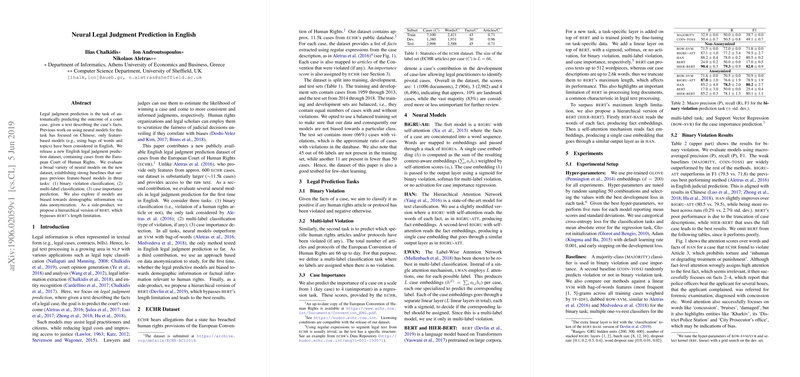An Examination of Neural Approaches to Legal Judgment Prediction in English Jurisdiction
The paper "Neural Legal Judgment Prediction in English" explores the application of neural models to the task of predicting legal outcomes using case facts from the European Court of Human Rights (ECHR). This paper is noteworthy for its release of a comprehensive English dataset and the testing of neural architectures on legal text processing, marking a development from the prior focus largely on Chinese legal cases and feature-based models.
The authors introduce a significant dataset comprising approximately 11.5k cases, which provides a broad foundation for training and evaluating machine learning models. This dataset stands out because it not only includes the raw text of the cases but is also significantly larger than previous datasets, enabling more robust model training and evaluation. The dataset is structured to address three distinct tasks: binary classification (identifying rights violations), multi-label classification (identifying specific articles/protocols violated), and case importance prediction (rating the significance of cases).
In applying neural networks, the authors benchmark a suite of models including a BiGRU with attention (BiGRU-Att), a Hierarchical Attention Network (HAN), a Label-Wise Attention Network (LWAN), and a modified version of BERT they call Hier-BERT. A notable contribution is the development of Hier-BERT to overcome the BERT model's limitation on processing long text sequences by adopting a hierarchical structure.
The results demonstrate that neural models outperform traditional SVM-based approaches utilizing bag-of-words, with Hier-BERT achieving superior performance, particularly in the task of binary classification. This suggests that deep learning methods have the potential to enhance the predictive accuracy and generalization to unseen data in the domain of legal judgment prediction. The authors also explore potential biases by using both anonymized and non-anonymized data, finding that certain models, particularly Hier-BERT, are susceptible to demographic biases.
While the models show promise, the prediction of specific articles (multi-label classification) remains challenging, especially for articles with few examples in the training set. This further emphasizes the need for methods that efficiently utilize limited data - a common scenario in legal document analysis. In case importance prediction, it is revealed that simply using the majority class achieves strong performance due to the skewed distribution of cases, highlighting the complexity and potential external factors influencing these judgments in practice.
From a broader perspective, this paper indicates the suitability of hierarchical neural architectures combined with attention mechanisms for processing and analyzing lengthy and complex legal documents. The adoption of these advanced architectures suggests positive implications for aiding legal practitioners by providing preliminary case assessments and highlighting potential biases for further human scrutiny.
The research opens several avenues for future exploration, such as extending these models to handle multilingual datasets or applying them to diverse legal systems like the US Supreme Court or the European Court of Justice. Moreover, developing models to produce interpretable results is critical, given the legal domain's demand for transparency and accountability. By advancing with this work, legal AI systems could bridge significant gaps in efficiency, accessibility, and bias detection, ultimately supporting fairer judicial processes.
